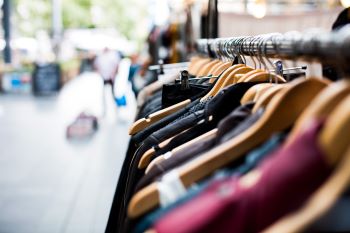Exploring the Future of Sustainable Fashion

Photo by Artificial Photography on Unsplash
November 17, 2022
Consumers are making a more concerted effort towards sustainability and the environment, a recent survey conducted by Deloitte found. Out of those surveyed, 40 percent said they chose brands based on their environmentally sustainable practices and values. The shift is across goods and services, including fashion. Some examples of sustainable fashion brands you may have heard of include Kotn, Everlane, and Pact as well as more household names like Levi’s and Patagonia.
So what does sustainability mean in fashion?
Creating Circularity Within Fashion
The Chang School’s Fashion Innovation Instructor Jennifer Pilkington says it means to rework the fashion system and all systems that are connected to it, like influencers and technology, so that it’s circular with the ultimate goal of zero waste and pollution.
“The end goal of sustainability in fashion is circularity, which means leaving nothing in the system,” says Jennifer. “Currently, we have raw materials that are designed and produced, used by consumers, and thrown out.”
In order to close the loop and help eliminate waste and pollution, those raw materials can be used and produced but then recycled into raw materials or textiles or garments that are ready to be used again instead of thrown away. There’s also ways that consumers can help to change the “use” stage to keep fashion in use longer by renting, reselling, and redesigning items.
“All those things work to build that circularity in fashion,” says Jennifer.
Beyond making that choice based on personal beliefs, the Deloitte survey found that consumers in 2022 were also driven by fewer choices and opportunities due to inflation and supply chain disruptions. When looking for ways to spend less, consumers are increasingly opting for more durable goods that last longer and items that can be reused or repaired easily. Fifty-four percent of respondents said they repaired or fixed an item instead of replacing it with a brand new equivalent item, and nearly 40 percent paid extra for a more durable or long-lasting product.
Committing to Sustainable Methods
There are some fashion brands that are incorporating technology to achieve greater sustainability in their processes. This includes PVH’s Tommy Hilfiger brand, which has committed to 100 percent digital design. CEO Daniel Grieder says that the company will only use 3D design to create, develop and sell samples from its Spring 2022 apparel collections onward.
The 3D design process enables designers to create pieces without any fabric, drawings, or patterns thereby skipping the sampling process altogether. In addition to cutting down on waste, it also saves fashion designers time in that it shortens the design process. Taking it one step further, if designers use digital showrooms, then they will no longer be producing tons of garments to be shown around showrooms but just one product that’s shown to the consumer on their website. And that gets us one step closer to manufacturing on-demand, or producing a garment only once a consumer orders their size online.
“You really can’t tell the difference online,” says Jennifer, referring to the digital versus physical sample of the garment.
Knowing What to Look For
Examples like this are helping move the needle in terms of sustainability in fashion but for the everyday consumer, how can they know whether they’re buying from a fashion label that’s sustainable? Jennifer points out that different certifications vary by region but she said one to look out for is B Corp Certification. The designation indicates that a business is meeting high standards of verified performance, accountability, and transparency on factors from employee benefits and charitable giving to supply chain practices and input materials.
“Having B Corp status helps address the delta between marketing and impact, clarifying what is greenwashing and who has a meaningful sustainable business ,” says Jennifer, adding that luxury fashion label Chloé and outerwear company Patagonia are examples of companies that have attained this status.
Jennifer added that some things to look for when trying to determine if a fashion company is sustainable is how far away something is made from where you are.
Another thing you can do, she says, is look at the care tag on the garment to see whether it was made with a high percentage of synthetic fibers, which are a form of microplastics that get in the water and aren’t biodegradable, and chemical washes that come off in the wash and enter the waste stream. Some companies even add excess packaging such as sealing a t-shirt in plastic when you order it online, so Jennifer advises to look for companies that don’t use that practice.
Making Sustainable Fashion More Affordable
Sustainable fashion is all well and good but it can be expensive because innovative systems and materials like mycelium and recycled plastics are still being developed for mass market use. Jennifer has budget-friendly ways consumers can shop sustainably. “Second-hand shopping is fashionable,” she says, adding that consumers can also consider shopping for longevity.
In other words, buying fewer pieces of clothing in their wardrobe that will last longer instead of many pieces that they’ll end up throwing away because they are poorly made or no longer wear them as they’re out of fashion. For that reason, Jennifer says the “capsule wardrobe” – having a few pieces of clothing that all go with each other giving you a larger wardrobe is a good place to start.
Going back to the example of PVH’s Tommy Hilfiger, mentioned earlier in the article, Jennifer says this can have a positive effect on the industry as a whole and eventually lower the cost of sustainably-produced clothing if more fashion labels get on board.
“Right now everyone is working in silos and it’s not a fully connected system,” she says.”We’re still a long way away but there are initiatives there.”
Jennifer recently spoke about sustainability at an online panel event, “Emerging Careers in the Canadian Fashion Industry,” hosted by The Chang School.
